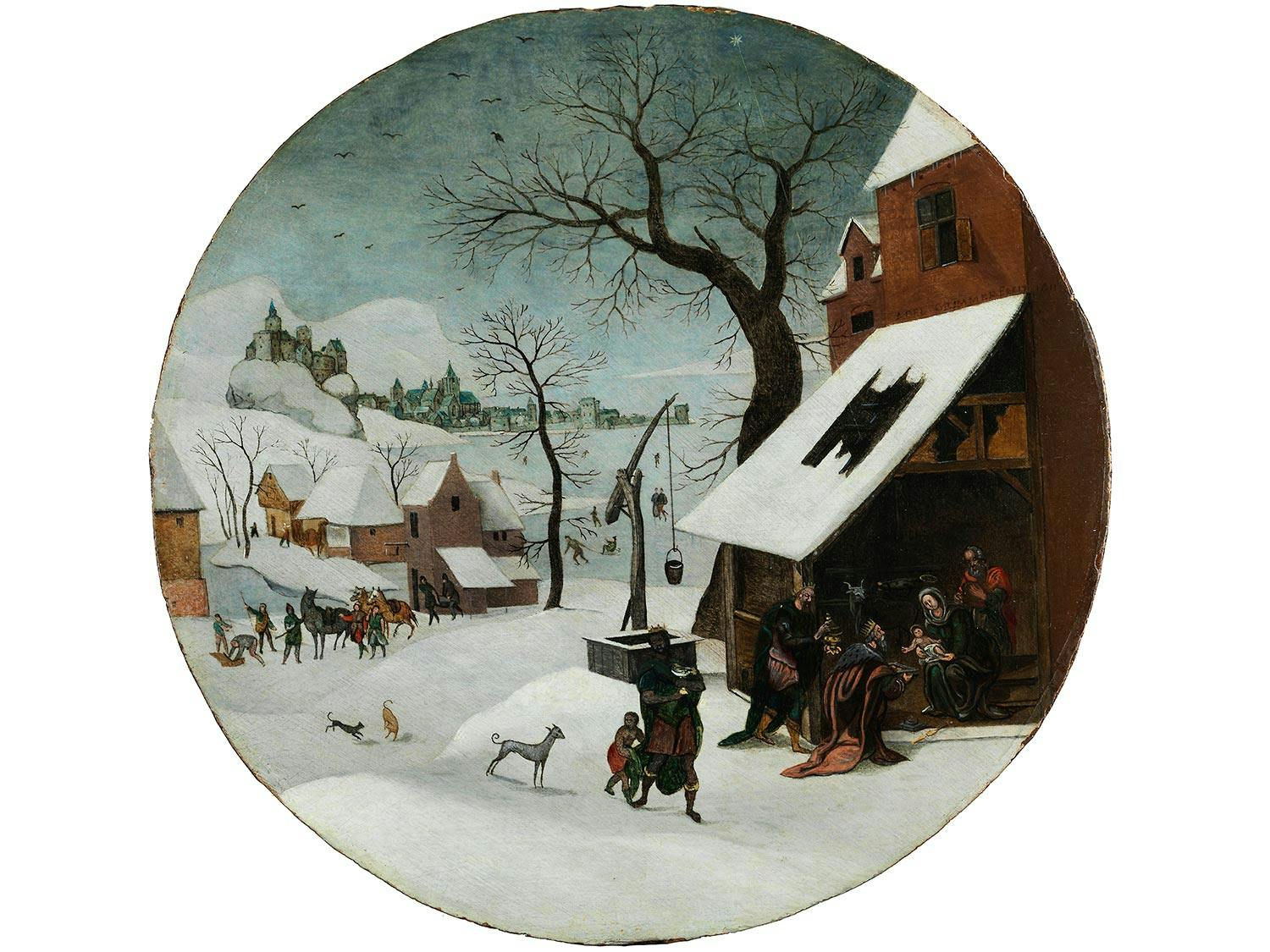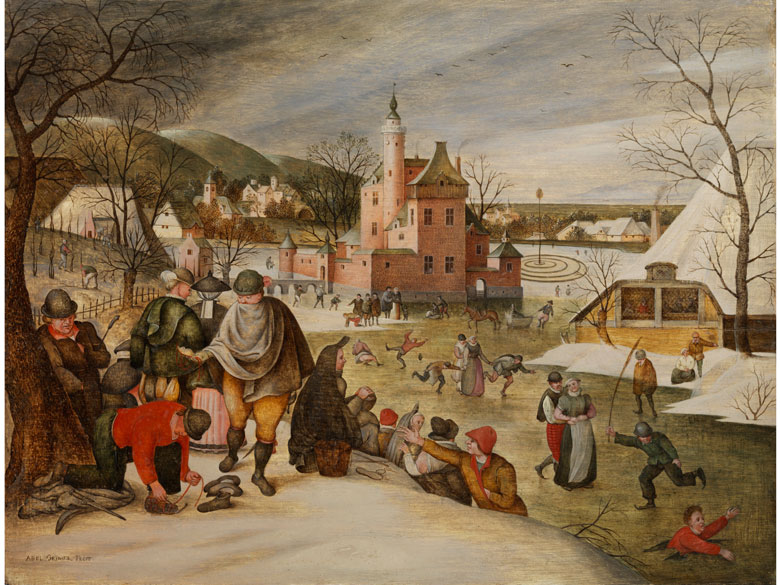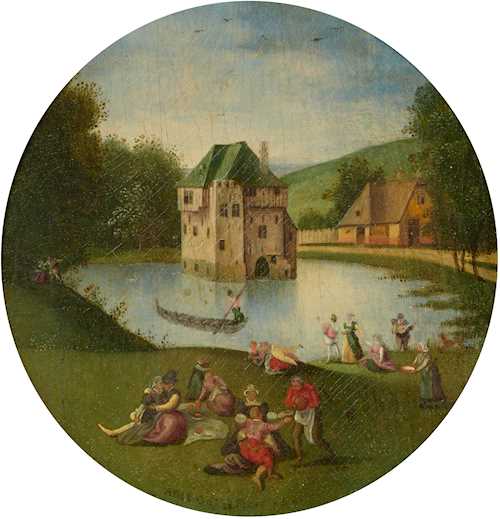(Antwerp 1570 - after 1620) A winter landscape with skaters, oil on panel, 50 x 76 cm, framed Provenance: Private collection, Belgium; sale, de Vuyst, Lokeren, 10 March 2018, lot 3; where acquired by the present owner We are grateful to Luuk Pijl for confirming the attribution to Abel Grimmer his certificate (13 August 2020) accompanies the lot. Pijl suggests that ‘a date of execution during the 1590s, when the master was very prolific, is most likely’. The present winter landscape, with its evocatively costumed figural groups and undulating snowy terrain, is an important addition to the oeuvre of Abel Grimmer Its exact subject has so far eluded scholars, but its motifs are familiar. As Pijl states, both Abel and his father the renowned landscape painter Jacob Grimmer worked in the wake of the great Pieter Brueghel the Elder (1526–1629). The current panel shows Abel Grimmer interpreting figures from Brueghel’s drawing Skaters before the Gate of Saint George circa 1558 (private collection) which was engraved by Frans Huys and published by Hieronymus Cock Metropolitan Museum, New York, (inv. no. 26.72.24) and The Hunters in the Snow, circa 1565 (Kunsthistorisches Museum, Vienna, inv. no. 1838). The current work, Pijl writes, exhibits Grimmer’s ‘straightforward forms, naïve figures, that show bright colours and strong linearity, with buildings rendered as geometric shapes.’ In conjunction his father Jacob, whose workshop and models he inherited in 1590, Grimmer popularised the genre of typically Flemish landscapes. Unlike Grimmer’s painting of Skaters before the Gate of Saint George (see. R. de Bertier de Sauvigny, Jacob et Abel Grimmer Catalogue Raisonné, Brussels 1991, p. 237, no. LXXIV), which is much closer to Brueghel’s overall compositional scheme, the present work shows an original winter landscape. Here the expansive snow is modelled thickly over the countryside, with shadow cast upon it by both the buildings and figures in a way that evokes the condition of crisp wintry light and also helps to articulate the forms in a characteristically Grimmer-esque manner. The hunter in the foreground reminds the viewer that the last quarter of the 16th century heralded the start of a mini ice age, with overall temperatures dropping by 2 degrees Celsius, shortening the ripening time for crops by three weeks and causing famines that led to increasingly desperate foraging. The cowled man carries a dead fox on his spear, a device first used by Brueghel in 1565 to indicate the sparsity of food, and a poignant testament to climate change in the Early Modern Period. Grimmer repeats this figure in his Winter Scene preserved in the Musée Royaux des Beaux-Arts, Brussels. Conversely, well dressed skaters in fashionable masks frolic on the ice nearby. Whether these masks were a device against the extreme cold (as depicted generations later in Wenceslaus Hollar’s The Winter Habit of a Gentlewoman engraving of 1643, Metropolitan Museum, inv. no. 23.65.35) or for festive purposes, still intrigues modern scholars. The slightly grotesque and leering masks, in the present work, are identified by Pijl with those found in Frans Hogenberg’s print of 1559 entitled Battle between Carnival and Lent, whose themes Brueghel also developed in his painting of the same name. Masks of an apparently similar construction may also be perceived in Brueghel’s Children’s Games, Vienna, Kunsthistorisches Museum, inv. no. GG 1017. Also drawn from Frans Huys’s aforementioned print of Skaters before the Gate of Saint George are the other two of the three figural groupings in the foreground, firstly the old crone pointing to the skaters with a cowled figure beside her, and the two seated men putting on skates in the centre, but rendered here with Grimmer’s typical handling. Later impressions of Huys’s engraving, which are contemporaneous to the present work, had ‘slibberachticheyt van’s menschen leven’ inscriptions added to them, suggesting, as the icy setting of this pa
(Antwerp 1570 - after 1620) A winter landscape with skaters, oil on panel, 50 x 76 cm, framed Provenance: Private collection, Belgium; sale, de Vuyst, Lokeren, 10 March 2018, lot 3; where acquired by the present owner We are grateful to Luuk Pijl for confirming the attribution to Abel Grimmer his certificate (13 August 2020) accompanies the lot. Pijl suggests that ‘a date of execution during the 1590s, when the master was very prolific, is most likely’. The present winter landscape, with its evocatively costumed figural groups and undulating snowy terrain, is an important addition to the oeuvre of Abel Grimmer Its exact subject has so far eluded scholars, but its motifs are familiar. As Pijl states, both Abel and his father the renowned landscape painter Jacob Grimmer worked in the wake of the great Pieter Brueghel the Elder (1526–1629). The current panel shows Abel Grimmer interpreting figures from Brueghel’s drawing Skaters before the Gate of Saint George circa 1558 (private collection) which was engraved by Frans Huys and published by Hieronymus Cock Metropolitan Museum, New York, (inv. no. 26.72.24) and The Hunters in the Snow, circa 1565 (Kunsthistorisches Museum, Vienna, inv. no. 1838). The current work, Pijl writes, exhibits Grimmer’s ‘straightforward forms, naïve figures, that show bright colours and strong linearity, with buildings rendered as geometric shapes.’ In conjunction his father Jacob, whose workshop and models he inherited in 1590, Grimmer popularised the genre of typically Flemish landscapes. Unlike Grimmer’s painting of Skaters before the Gate of Saint George (see. R. de Bertier de Sauvigny, Jacob et Abel Grimmer Catalogue Raisonné, Brussels 1991, p. 237, no. LXXIV), which is much closer to Brueghel’s overall compositional scheme, the present work shows an original winter landscape. Here the expansive snow is modelled thickly over the countryside, with shadow cast upon it by both the buildings and figures in a way that evokes the condition of crisp wintry light and also helps to articulate the forms in a characteristically Grimmer-esque manner. The hunter in the foreground reminds the viewer that the last quarter of the 16th century heralded the start of a mini ice age, with overall temperatures dropping by 2 degrees Celsius, shortening the ripening time for crops by three weeks and causing famines that led to increasingly desperate foraging. The cowled man carries a dead fox on his spear, a device first used by Brueghel in 1565 to indicate the sparsity of food, and a poignant testament to climate change in the Early Modern Period. Grimmer repeats this figure in his Winter Scene preserved in the Musée Royaux des Beaux-Arts, Brussels. Conversely, well dressed skaters in fashionable masks frolic on the ice nearby. Whether these masks were a device against the extreme cold (as depicted generations later in Wenceslaus Hollar’s The Winter Habit of a Gentlewoman engraving of 1643, Metropolitan Museum, inv. no. 23.65.35) or for festive purposes, still intrigues modern scholars. The slightly grotesque and leering masks, in the present work, are identified by Pijl with those found in Frans Hogenberg’s print of 1559 entitled Battle between Carnival and Lent, whose themes Brueghel also developed in his painting of the same name. Masks of an apparently similar construction may also be perceived in Brueghel’s Children’s Games, Vienna, Kunsthistorisches Museum, inv. no. GG 1017. Also drawn from Frans Huys’s aforementioned print of Skaters before the Gate of Saint George are the other two of the three figural groupings in the foreground, firstly the old crone pointing to the skaters with a cowled figure beside her, and the two seated men putting on skates in the centre, but rendered here with Grimmer’s typical handling. Later impressions of Huys’s engraving, which are contemporaneous to the present work, had ‘slibberachticheyt van’s menschen leven’ inscriptions added to them, suggesting, as the icy setting of this pa





.jpg)


.jpg)

.jpg)

.jpg)


Try LotSearch and its premium features for 7 days - without any costs!
Be notified automatically about new items in upcoming auctions.
Create an alert